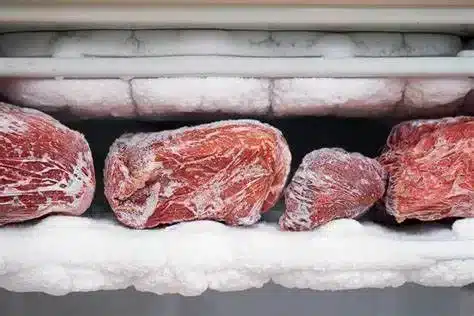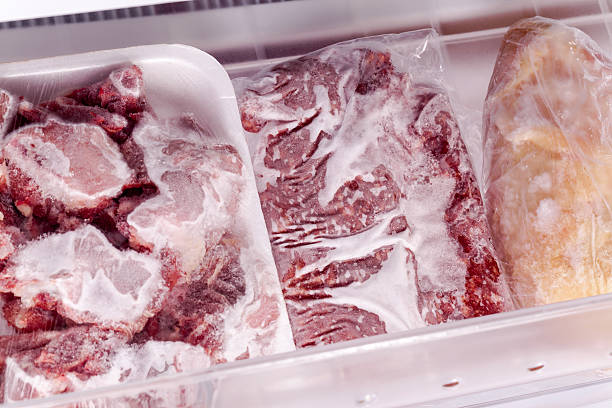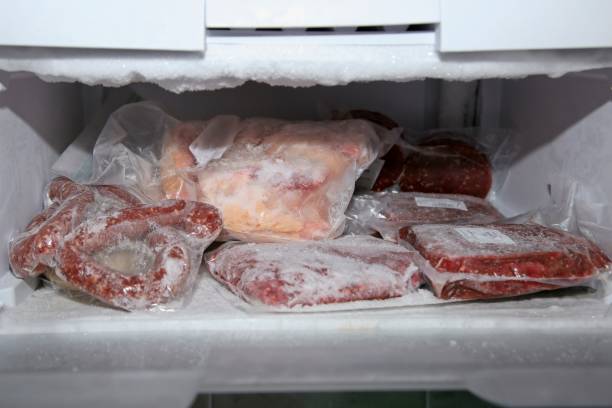
If you’re a meat lover, you might have wondered how much meat you can store in your freezer. Whether you’re buying in bulk, stocking up for emergencies, or planning to butcher your own livestock, knowing how to calculate freezer space for meat is a useful skill. In this post, we’ll show you how to estimate the meat capacity of a 20 cu ft freezer, and give you some tips on how to make the most of your freezer space.
The general rule for how much freezer space is needed for meat is one cubic foot per 35-40 pounds of packaged meat. A 20 cu ft freezer can hold about 700-800 pounds of meat.
To calculate how much meat you can fit in your freezer, you need to know two things: the volume of your freezer and the weight of your meat. The volume of your freezer is usually measured in cubic feet (cu ft), and you can find it on the manufacturer’s label or manual. The weight of your meat depends on the type, cut, and packaging of the meat.
The general rule for how much freezer space is needed for meat is one cubic foot per 35-40 pounds of packaged meat. This means that for every 35-40 pounds of meat, you need one cubic foot of space in your freezer. This rule applies to most types of meat, such as beef, pork, chicken, turkey, lamb, etc.
However, this rule is not exact, and it may vary depending on the shape and size of the meat packages. For example, if you have large or odd-shaped cuts, such as bone-in roasts or soup bones, you may need more space than the rule suggests. On the other hand, if you have small or compact packages, such as ground beef or sausage links, you may need less space than the rule suggests.
To get a more accurate estimate of how much freezer space you need for your meat, you can use a simple formula:
Freezer space (cu ft) = Weight of meat (lbs) / 40
This formula assumes that you have an average of 40 pounds of meat per cubic foot of freezer space. You can adjust this number up or down depending on the shape and size of your meat packages.
For example, if you have 500 pounds of meat, you can use this formula to estimate how much freezer space you need:
Freezer space (cu ft) = 500 / 40 Freezer space (cu ft) = 12.5
This means that you need about 12.5 cubic feet of freezer space to store 500 pounds of meat.

Now that you know how to calculate freezer space for meat, you can apply this knowledge to estimate how much meat a 20 cu ft freezer can hold. A 20 cu ft freezer is a large-sized freezer that can fit in most garages or basements. It can store a lot of food for a long time, making it ideal for families or preppers.
Using the formula above, you can estimate how much meat a 20 cu ft freezer can hold by multiplying the volume of the freezer by 40:
Weight of meat (lbs) = Freezer space (cu ft) x 40 Weight of meat (lbs) = 20 x 40 Weight of meat (lbs) = 800
This means that a 20 cu ft freezer can hold about 800 pounds of meat.
However, this is only an estimate, and it may vary depending on the shape and size of your meat packages. If you have large or odd-shaped cuts, such as bone-in roasts or soup bones, you may need less than 800 pounds of meat to fill up your freezer. If you have small or compact packages, such as ground beef or sausage links, you may need more than 800 pounds of meat to fill up your freezer.
To get a more accurate estimate of how much meat a 20 cu ft freezer can hold, you can weigh your meat packages before putting them in the freezer. You can also use a tape measure to measure the dimensions of your freezer and your meat packages, and then use some math to calculate the volume and weight of your meat.
If you want to store as much meat as possible in your 20 cu ft freezer, here are some tips on how to make the most of your freezer space:

Q: How long can I store meat in my freezer?
A: The shelf life of meat in the freezer depends on the type, cut, and packaging of the meat. Generally, frozen meat can last from 2 months to a year or more in the freezer. Here are some guidelines for how long different types of meat can last in the freezer:
Q: How do I thaw frozen meat safely?
A: The safest way to thaw frozen meat is in the refrigerator. This will prevent bacterial growth and preserve the quality of the meat. Depending on the size and thickness of the meat, it may take from several hours to a few days to thaw completely in the refrigerator. You can also thaw frozen meat in cold water or in the microwave, but these methods are faster and less safe than thawing in the refrigerator. You should never thaw frozen meat at room temperature, as this can lead to spoilage and foodborne illness.
Q: How do I prevent freezer burn on my meat?
A: Freezer burn is a condition that occurs when frozen food is exposed to air and moisture, causing it to lose its color, flavor, and texture. Freezer burn does not make the food unsafe to eat, but it reduces its quality and appeal. To prevent freezer burn on your meat, you should:
Knowing how to calculate freezer space for meat is a useful skill that can help you store more food for longer periods of time. A 20 cu ft freezer can hold about 700-800 pounds of meat, depending on the shape and size of your meat packages. To make the most of your freezer space, you should choose vacuum-sealed or tightly wrapped packages, choose boneless or deboned cuts, arrange your packages in an organized and efficient way, label your packages with the name, weight, and date of the meat, rotate your packages regularly, and follow proper freezing and thawing guidelines.
We hope this post has helped you learn how to estimate the meat capacity of a 20 cu ft freezer. If you have any questions or comments, please feel free to leave them below. And if you’re looking for more tips on how to use kitchen appliances and food safety, don’t forget to check out our blog at PressToCook.com!
